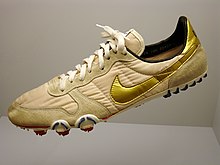Spikes (athletics)
Spikes ( nail shoes ) are shoes common in athletics with thorns attached to the sole. On the one hand, this enables more efficient power transmission, and on the other hand, grip is significantly improved, which is a considerable advantage, especially on a wet track.
variants
Due to the diverse requirements placed on spikes, discipline-specific shoes have been developed over time. Generally, the thorns are placed at the level of the front third of the sole of the foot. However, especially in the javelin and high jump disciplines, thorns can be attached at heel level.
Running disciplines
In the running disciplines, the hardness or cushioning of the shoe essentially varies. If the sprint shoe usually has a rigid, hard plastic plate as the sole and no heel padding, a medium- or long-distance shoe has a rather flexible sole and has padding in the heel area. In addition, a distinction can be made between short sprint and long sprint spikes. With increasing racing distance, the hardness of the shoe decreases and at the same time the padding increases. The thorns, which are limited to a certain length, are only located in the front third of the shoe sole, since this is where the imprint from the ball of the foot takes place during the forefoot. Thorns at heel height would only hinder the runner unnecessarily when rolling. The typical length of the individual spikes is 3–9 millimeters, depending on the use and shoe model on the track. In cross-country skiing , spikes up to 15 mm are used, depending on the nature of the ground. Usually the spikes can be exchanged individually, but shoes with permanently installed spikes are also manufactured.
Brush shoes
In preparing for the 1968 Olympic Games called were brushing shoes (Engl. Brush spikes ) used the 68 thorns instead of the usual four or six spines had achieved and better adhesion to the newly developed tartan tracks. However, they were not approved for international comparisons and came out of use again, since they destroyed the tartan track more and more after a short time due to the high number of thorns. The US sprinters John Carlos ( 200 m ), Vince Matthews and Lee Evans ( 400 m ) achieved world bests with them in the summer of 1968, which, however, were not recognized as world records by the IAAF . Similar brush shoes are still worn by bobsleigh athletes.
Throwing disciplines
No spikes are used in the throwing disciplines of the shot put , discus and hammer throw , because the athletes throw their devices from a so-called throwing circle, the floor of which is made of concrete. In the javelin throw, however, spikes are practically indispensable. They are generally higher than the usual all-round spikes, as very strong forces act on the ankles during the release and therefore a certain amount of support is advantageous. Furthermore, they also have thorns in the heel area, because when thrown the whole foot is placed flat on the ground.
Jump disciplines
Shoes that are very similar to sprint spikes are used for the long , three and pole vault disciplines . For the high jump , spikes are used which are a little higher than normal spikes, since enormous forces act on the ankle joint when jumping. High jump shoes also have additional thorns in the heel area, as the foot is completely placed on the ground when jumping.
Web links
Individual evidence
- ↑ B. Smit: The Dasslers: Three strips against Puma. Bastei Lübbe, 2007, ISBN 978-3-404-61608-4 , p. 92. Restricted preview in the Google book search
- ↑ U. Jonath: Practice of Athletics. Bartels & Wernitz, 1973, p. 11.

